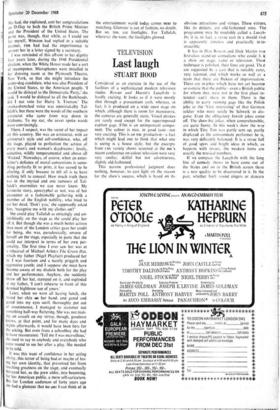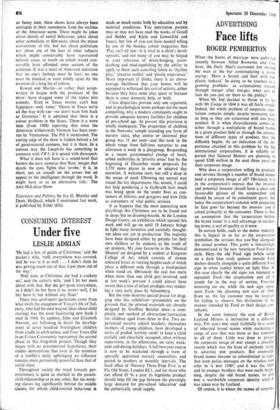Last laugh
TELEVISION STUART HOOD
Considered as an exercise in the use of the facilities of a sophisticated modern television studio, Rowan and Martin's Laugh-In is hardly exciting. It looks as if it were mostly shot through a proscenium arch, whereas, in fact, it is produced on a wide open stage on which, although there is room for manoeuvre, the cameras are generally static. Visual devices are rarely used except for the superimposed caption gags. Film is an unimportant compo- nent. The colour is nice, in good taste—not very exciting. This is an NBC production—a fact which might lead one to think that what one is seeing is a house style; but the excerpts from CBS variety shows screened at the BBC'S recent conference on colour television were very very similar, skilful but not adventurous, slightly old-fashioned.
This narrow professional judgment does nothing, however, to cast light on the reason for the show's success, which is based on its obvious attractions and virtues. These virtues. like its defects, are old-fashioned ones. The
programme may be modishly called a Laheh- In; it is, in fact, a revue cast in a mould that is apparently timeless and practically in-le- structible.
It has in Dan Rowan and Dick Martin two first-class stand-up comedians who could li: It a show on stage, radio or television. Them technique is polished, their lines are good. The y are supported by a cast that is suitably zany. very talented, and which works so well as e team that there arc flickers of improvisation. • There are in-jokes which have not yet become so esoteric that the public—even a British public for whom they were not in the first place in- tended—can't share in them. There is the ability to carry running gags like the Polish joke or the 'Very interesting' of that German soldier who must surely be Schweik in dis- guise. Even the obligatory Jewish jokes come off. The show-biz jokes, when comprehensible, are quite funny. In this week's show the way in which Tiny Tim was partly sent up, partly displayed as the consummate performer he is, was very delicately balanced. It is a revue full of good spots and bright ideas in which, as happens with revues, the weakest items are usually the musical numbers.
If we compare the Laugh-In with the long line of comedy shows to have come out of the States and on to the British screen there is a new quality to be discovered in it. In the past, whether built round singers or dancers
or funny men, these shows have always been antiseptic in their remoteness from the realities of the American scene. There might be jokes about details of social behaviour, jokes about other comedians or film-stars, about the minor conventions of life, but not about politicians nor about any of the host of other subjects which might conceivably have represented delicate areas, to touch on which would con- ceivably have offended some section of the audience. It was a tenet of American television that no one's feelings must be hurt; no one must be shocked or even mildly upset by the mention of a long list of taboos.
Rowan and Martin—or rather their script- writers in league with the producer of the show—have dragged some of the topics into comedy. 'Even in Texas money can't buy happiness—only votes.' Down in Texas we're all the way with Lar—we don't want him back as Governor.' It is admitted that there is a colour problem in the States. There is a news item (from 1988) reporting that since the American withdrawals Vietnam has been over- run by Vietnamese. The Pill is mentioned. The cutting edge of the show is hidden behind a lot of good-natured zaniness, but it is there. In a curious way the Laugh-In has something in common with TW3; it is spiced with disrespect.
What it does not have is a sound-level that batters the ears; cameras that flare; images that dazzle the eyes; lights that 'strobe.' It is, in short, not an assault on the senses but an appeal to the intelligence through the word. It might have as as an alternative title: The Anti-McLuhan Show.
Television and Politics, by Jay G. Blumler and Denis McQuail, which I mentioned last week, is published by Faber (63s).



































 Previous page
Previous page